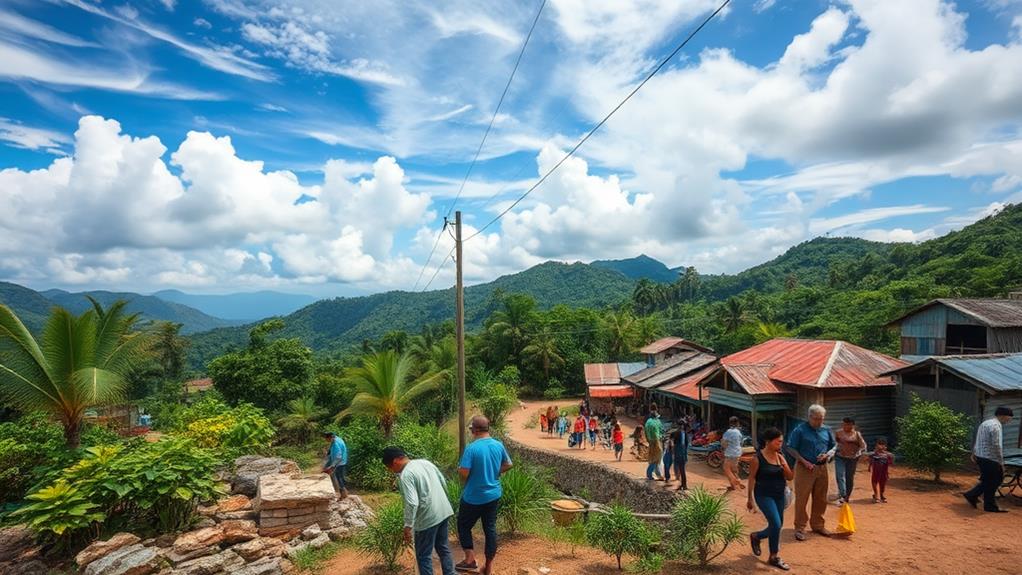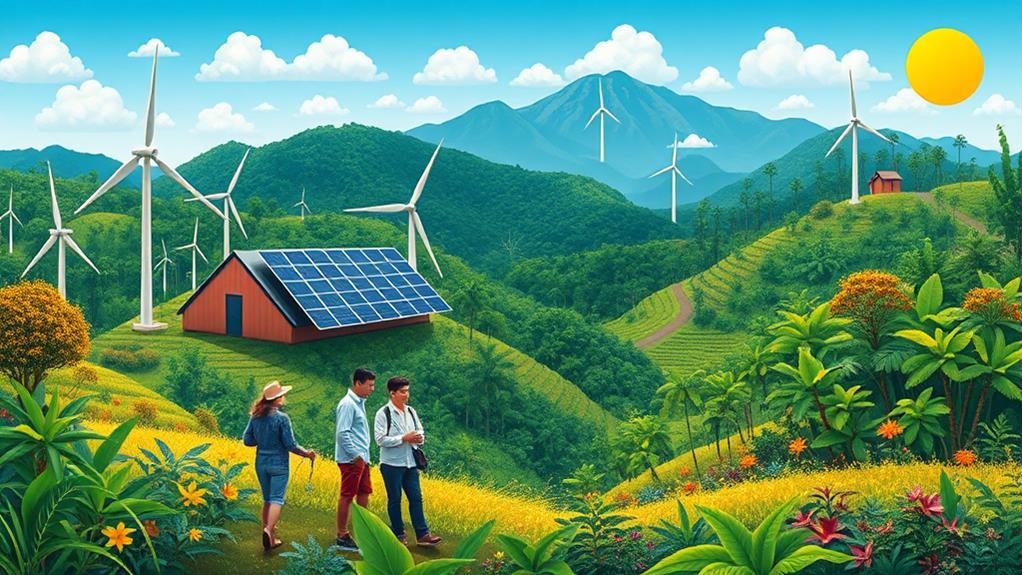Research and Development (R&D) in natural resources is important for a sustainable future in the Philippines. R&D leads to new ideas that can help farmers grow more food. For example, new farming techniques can increase crop yields, while better management helps preserve forests and water resources.
Programs like WAVES help include natural resource accounting in government planning. This ensures that resources are used responsibly and sustainably.
With more funding and cooperation among different agencies, R&D can address urgent problems such as food security and biodiversity loss.
By focusing on technology and involving local communities, R&D helps people adapt to changes in the environment. Staying aware of these advancements can provide valuable insights into how natural resources can support the country's development.
Overview of Natural Resources

The Philippines has many valuable natural resources, which present both opportunities and challenges. The country is rich in minerals such as gold, copper, nickel, and chromium. Records show that from 2000 to 2012, there were detailed accounts of these minerals.
However, it's important to use these resources wisely to protect the environment and the services it provides, which are essential for the well-being of people.
Agriculture, forestry, and fisheries are vital for the livelihoods of millions of Filipinos. However, these sectors are threatened by natural disasters and poor resource management. For instance, the country generates about 2.7 million tons of plastic waste each year, highlighting the need for better management of natural resources and pollution control.
Additionally, studies in areas like the Laguna Lake basin and Southern Palawan show that valuing natural resources is crucial for the country's economy.
To address these issues, the Philippines must adopt innovative strategies for sustainable resource use. This will help ensure that the country's natural wealth benefits both current and future generations while preserving vital ecosystem services.
Role of Research and Development
Research and Development (R&D) is essential for managing the Philippines' natural resources sustainably. R&D focuses on creating evidence-based policies that help solve problems related to ecosystems and natural assets. The Philippine Council for Agriculture, Aquatic and Natural Resources Research and Development (PCAARRD) plays a crucial role in coordinating national research efforts with development goals, which improves resource resilience.
Investing in R&D has resulted in useful technologies like the Automatic Furrow Irrigation System (AFIS). This system saves water and increases farmers' incomes, demonstrating how research can promote sustainable farming.
Additionally, studies, such as one conducted on Bataan Natural Park, show that valuing natural resources can lead to economic benefits through ecosystem services.
To enhance R&D's effectiveness, institutional reforms and greater public support are necessary to fix issues in the agricultural research system. By focusing on these areas, the Philippines can manage its natural resources better, which will support both economic growth and environmental health.
Economic Impact of R&D

Investing in research and development (R&D) is vital for the Philippine economy, especially in agriculture. R&D helps improve agricultural productivity and ensures food security. Since the 1980s, the agriculture sector has faced challenges due to low funding for agricultural research.
This lack of investment has led to a gap between how much is spent on research and the importance of agricultural products. As a result, the agricultural research system hasn't been as effective as it could be.
The Philippine Technology Transfer Act of 2009 was created to address this issue. It promotes the commercialization of new technologies from R&D, aiming to build innovation in agriculture and aquaculture. For example, the Automatic Furrow Irrigation System (AFIS) allows farmers to significantly increase their income, sometimes doubling or tripling it.
To fully benefit from these advancements, it is crucial to strengthen research agencies within the Department of Agriculture and the Department of Environment and Natural Resources. This will help promote new technologies and protect natural resources.
By focusing on R&D in agriculture, the Philippines can improve food security and enhance the livelihoods of its people.
Case Studies From WAVES
WAVES-Philippines shows how resource accounting can help with sustainable development. For example, WAVES created accounts for important minerals like gold, copper, nickel, and chromium from 2000 to 2012. This information helps stakeholders make better decisions about resource management.
WAVES also conducted a study on mangrove accounts to highlight the importance of coastal ecosystems in resource management. They're collecting ongoing data to support this. Additionally, they've created ecosystem accounts for the Laguna Lake basin and Southern Palawan. These accounts are being analyzed to guide effective sustainable development.
WAVES works at the local level by establishing accounts in places like the Pulot watershed and the municipality of Sofronio Espanola. They collaborate with key government agencies, such as the National Economic and Development Authority and the Department of Environment and Natural Resources.
This teamwork helps to integrate natural resources into national economic accounts and supports the goal of promoting sustainable development in the Philippines.
Government Initiatives and Support

The Philippine government is important for sustainable development through several key programs. These programs help use natural resources wisely while supporting economic growth.
Here are four main initiatives:
- WAVES Initiative: This program, led by NEDA, puts natural resources into the country's economic accounts. This helps create better development plans.
- PCAARRD Policies: The Philippine Council for Agriculture, Aquatic and Natural Resources Research and Development makes policies and gives funds to support sustainability and innovation in agriculture and natural resources.
- USAID Collaborations: The government works with USAID on projects that protect natural resources and improve water security for communities.
- Technology Transfer Act: This law encourages researchers to turn their new ideas and technologies into businesses, which helps improve agriculture and aquaculture.
These initiatives promote sustainable management of natural resources and increase agricultural productivity.
How does the impact of global markets affect the need for research and development in Philippine natural resources?
The impact of global markets on Philippine natural resources drives the need for extensive research and development. As demand and prices fluctuate, it is crucial to innovate sustainable resource management strategies to stay competitive. Understanding the global market trends is essential in maximizing the potential of Philippine natural resources.
Partnerships for Sustainable Development
Sustainable development in the Philippines relies on strong partnerships that combine resources and expertise from different areas. For example, the WAVES initiative is a program that includes natural resource accounting in national economic planning. This helps ensure that development is sustainable.
The National Economic and Development Authority (NEDA) works with various government agencies to improve the management of natural resources and create better policies.
Another important partnership is with USAID, which focuses on conservation and sustainable management. This collaboration helps reduce the effects of climate change and improve water security. By working with the Philippine government, these partnerships create effective resource management strategies.
Additionally, the Philippine Council for Agriculture, Aquatic and Natural Resources Research and Development (PCAARRD) collaborates with both local and international organizations. This partnership boosts research and development in agriculture and forestry. The goal is to improve people's livelihoods and build resilience against environmental challenges.
Lastly, the Meloy Fund has set aside $17.5 million over 12 years to encourage sustainable practices in fisheries. This fund promotes teamwork among stakeholders to improve resource management and food security.
Future Directions for R&D in Natural Resources

Innovation in research and development (R&D) for natural resources is important for the Philippines to address environmental challenges while growing the economy. Here are some future directions to consider:
- Valuation of Ecosystem Services: Understanding the value of ecosystem services helps create wealth and promotes sustainable practices. For example, studies in Bataan Natural Park show how valuing natural resources can lead to better conservation efforts.
- Technology Integration: Using mobile apps like SPIDTECH for pest management helps farmers increase productivity and resilience. This technology supports sustainable farming methods, allowing farmers to manage pests more effectively.
- Strengthening Research Agencies: It's essential to empower agencies like the Department of Agriculture and the Department of Environment and Natural Resources. These agencies can promote innovation and improve the efficiency of R&D efforts across the country.
- Commercialization of Technologies: Programs like the Regional Agri-Aqua Innovation System Enhancement (RAISE) aim to commercialize technologies developed through R&D. This drives economic growth, particularly in the agricultural sector, by turning research into practical solutions that can be used in the market.
These directions will help the Philippines achieve sustainable development while facing the challenges of climate change.
Questions and Answers
Why Is Research and Development Important in the Philippines?
Research and development (R&D) is very important in the Philippines. It helps improve the economy. For example, new agricultural techniques can increase crop yields, which supports farmers and boosts food supply. R&D also encourages innovation in policies. This can lead to better laws that protect the environment and enhance community welfare. Additionally, R&D promotes sustainable practices. For instance, developing renewable energy sources can reduce reliance on fossil fuels and protect natural resources for future generations. Overall, R&D plays a crucial role in addressing challenges and ensuring a better future for communities in the Philippines.
What Is the Importance of Research in Agriculture in the Philippines?
Research in agriculture is crucial for improving farming practices. It helps implement sustainable methods, which means farming in a way that protects the environment. For example, using crop rotation can maintain soil health and reduce pests.
It encourages crop diversification, allowing farmers to grow different types of crops. This reduces the risk of losing all their income if one crop fails. For instance, a farmer who grows rice and vegetables can still earn money if the rice crop does poorly.
It facilitates technology integration, which means using new tools and techniques to increase efficiency. For example, using drones for crop monitoring can help farmers identify problems early, leading to better yields.
What Is the Most Important Natural Resources in the Philippines?
The most important natural resources in the Philippines include mineral wealth, forests, and water resources. Mineral wealth, such as gold, copper, and nickel, is crucial for the country's economic growth. Forests in the Philippines provide timber and habitat for wildlife, while also playing a key role in maintaining the environment. Water resources, including rivers and lakes, are vital for agriculture and support the livelihoods of many Filipinos. Together, these resources are essential for the nation's development and sustainability.
What Factors Contribute to the Philippines Being Rich in Natural Resources?
The Philippines has a diverse geology and rich biodiversity. This unique environment leads to a variety of natural resources. Mineral wealth is abundant, including metals like gold, copper, and nickel. These resources not only support economic growth but also promote ecological sustainability. For example, mining can provide jobs and revenue, while careful management can protect the environment.